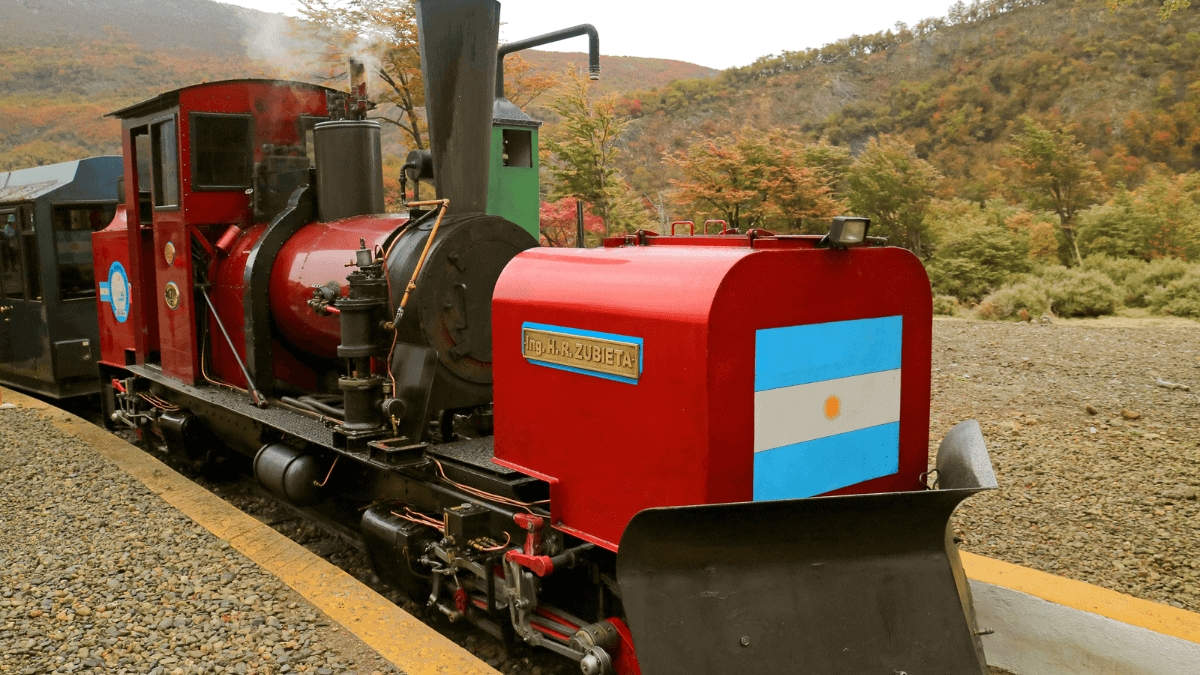Do you enjoy train rides? There’s something about viewing an amazing landscape from a train’s window, especially in a place full of natural wonders and vehicles steeped in fascinating history. Let’s explore Argentina trains and what different routes they offer.
When visiting Argentina, tourists have access to various train systems that offer smooth and efficient travel while avoiding traffic congestion. These Argentinian trains provide extensive coverage and scenic views, making them an ideal choice for exploring the country.
With convenient train tickets available, passengers can plan their intercity journeys easily and enjoy the comfort and convenience of the train services. The well-connected train network includes strategically located stations, ensuring efficient transportation and accessibility to various destinations.
Whether you want to experience vibrant cities or embark on a countryside adventure, Argentina’s train routes cater to diverse preferences. The inclusive design of the trains also ensures accessibility for passengers with disabilities.
Traveling by train in Argentina offers more than just transportation—it provides an opportunity for sightseeing and immersion in the country’s natural beauty. The train routes showcase breathtaking landscapes, including the majestic Andes Mountains, vast Pampas, and stunning coastline.
From luxurious trains with premium amenities to historic trains that have been operating since the eighteenth century, Argentina offers a range of options to suit different travel styles.
Seek a modern and comfortable journey or a nostalgic trip through time with these train tours in Argentina!
What Are The Best Novelty, Historical, and Tourist Trains?
In this section, we’ll explore different novelty, historical, and tourist trains throughout Argentina.
The country has one of the unique railway systems in the world, which British experts made in the 1800s. These famous trains which have historical value are quite famous, and these trains include:
1. Tren de la Costa in Buenos Aires
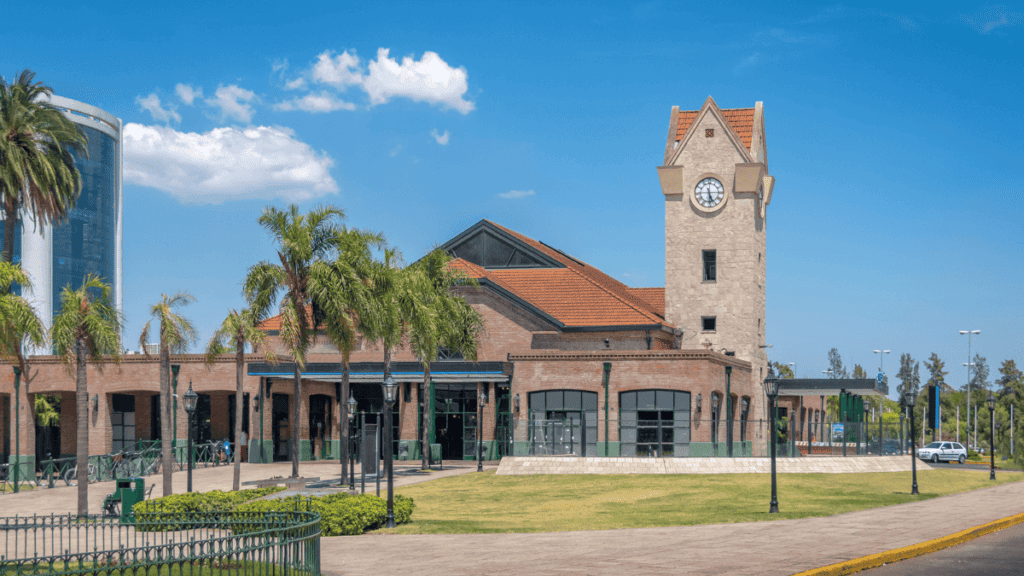
Tren de la Costa means the “train of the coast.” There are 9 to 10 trains in Buenos Aires, which have 2 compartments per train, with a compartment capacity for 200 passengers.
Built in the 1900s, it was once the most famous tourist transport because it offered a smooth trip and amazing views.
The train starts its route at the Maipú station, located in the northern suburb of Olivos, Buenos Aires. From there, it follows a 9.6-mile (15-kilometer) route that includes 11 stops, ending at the Delta station in Tigre, a charming town situated on the banks of the Paraná Delta.
Throughout the journey, the Tren de la Costa covers several notable destinations and attractions. Some of the prominent stops along the route include:
- Barrancas: This stop is known for its beautiful green spaces and serves as a gateway to the coastal area. Visitors can enjoy strolling along the waterfront promenade or exploring nearby parks.
- San Isidro: A historic district renowned for its elegant architecture, San Isidro offers visitors a chance to explore its charming town center, visit the San Isidro Cathedral, or relax in its quaint cafes.
- San Fernando: This stop is famous for its nautical clubs and waterfront activities. It’s a great place to enjoy boat rides, kayaking, or taking in the serene atmosphere of the riverside.
- Tigre: The final destination of the Tren de la Costa, Tigre is a popular tourist spot due to its natural beauty and cultural attractions. Visitors can explore the Paraná Delta by boat, visit the Museo de Arte Tigre, or enjoy a leisure stroll along the Paseo Victoria.
2. Tren A Las Nubes in Salta, Argentina
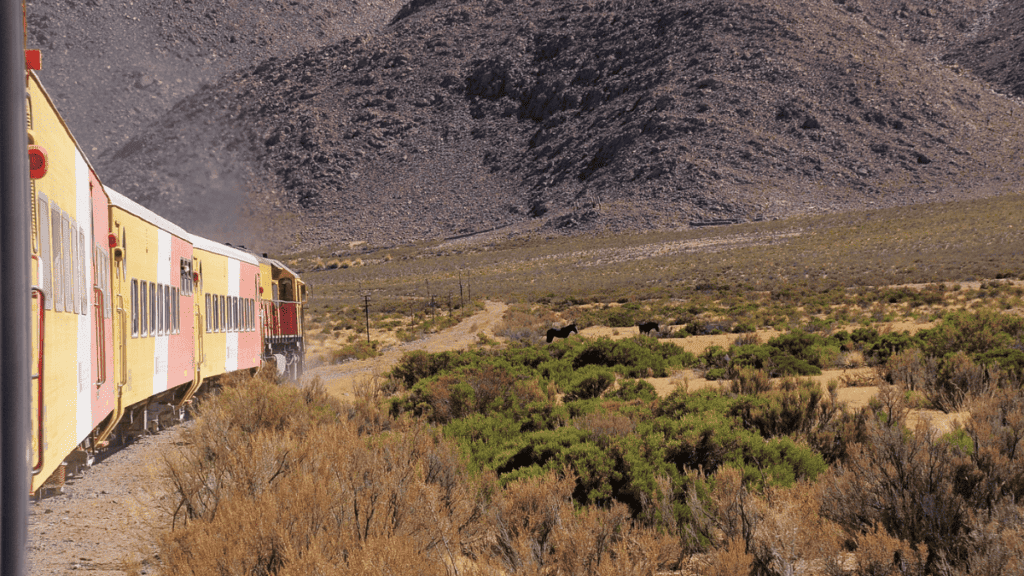
Tren A Las Nubes, which translates to “Train to the Clouds,” is a renowned railway journey in Salta, Argentina. This iconic train ride takes passengers on an extraordinary adventure through the scenic landscapes of the Andes Mountains, reaching impressive altitudes and offering breathtaking views along the way.
The railway system for Tren A Las Nubes became functional in 1921. The La Polvorilla viaduct, the highest point of the railway track, was completed in 1932. The train is specially built for tourists to have one of the best railway experiences in the world.
The train departs from Salta, located in northwestern Argentina, and embarks on a remarkable 217-mile (350 km) journey.
The route covers various cities and stops, including:
- Campo Quijano: This is the starting point of the journey, located approximately 18 mi (30 km) from Salta. Here, passengers board the train and prepare for an unforgettable experience.
- El Alfarcito: As the train moves up, it stops at this small village known for its handicrafts and traditional Andean culture. It’s an opportunity to interact with the locals and learn about their way of life.
- San Antonio de los Cobres: This is a significant stop along the route, situated at 13,842 ft (4,215 m) above sea level. Passengers can explore the town, visit the picturesque Santa Rosa de Tastil church, or indulge in local cuisine.
- La Polvorilla Viaduct: The highlight of the journey, the train crosses this iconic viaduct, an engineering marvel standing at an altitude of 13,842 ft (4,220 m). The viaduct offers awe-inspiring panoramic views of the surrounding mountains and is a favorite spot for photography.
Tren A Las Nubes is not only a train ride; it is an immersive cultural and natural experience. It showcases the extraordinary beauty of the Andes Mountains, allowing travelers to marvel at the breathtaking landscapes, interact with local communities, and appreciate the engineering marvels of the railway.
It has rightfully earned its reputation as one of the world’s most remarkable train journeys.
3. Train to the End of The World in Ushuaia, Argentina
The Train to the End of The World is also known as Tren del Fin del Mundo. It is one of the most popular trains in Ushuaia, Argentina, the southernmost city in the world, which will take you through a beautiful southern park, the Tierra del Fuego National Park.
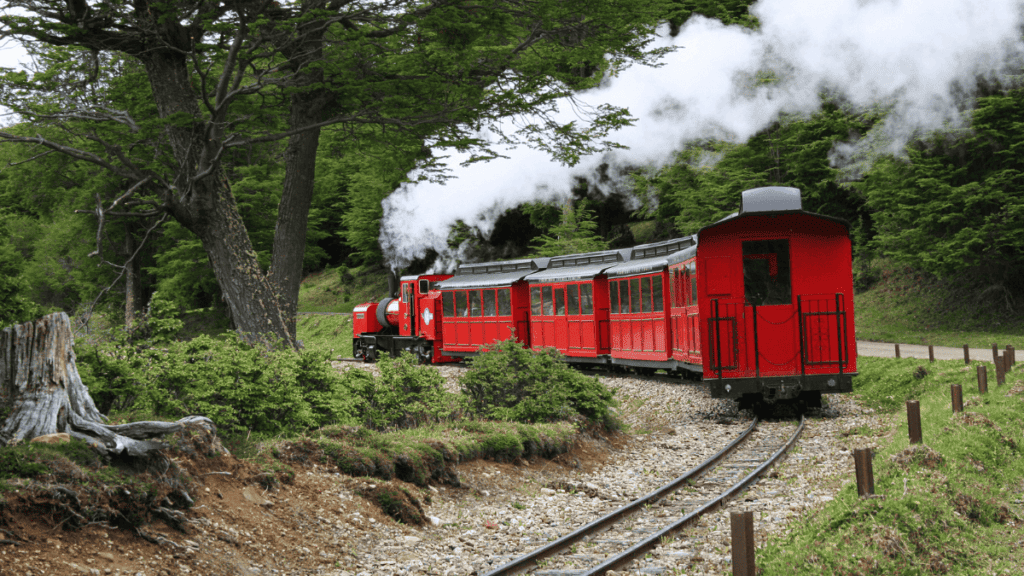
In the past, the Train to the End of the World was built to serve the Patagonian prison and to transport timber and prisoners from Ushuaia. This practice continued until 1947 when the prison was closed, and the train had lost its purpose. Years later, the train was reconditioned and rebuilt only to serve the tourists.
The train’s current route is reportedly 1-third of the actual route it traveled in the past. So, if you are traveling to Ushuaia, you should experience this train trip. It will cost you around 14,369 Argentine pesos (60 U.S. dollars) to travel and experience some of Argentina’s best views from the Tren del Fin del Mundo.
4. La Trochita (A.K.A. Old Patagonian Express)
La Trochita, known as the Old Patagonian Express, is a steam train from a narrow railway in Patagonia. The train provides an amazing view of the Patagonian plains and the Andean peaks.
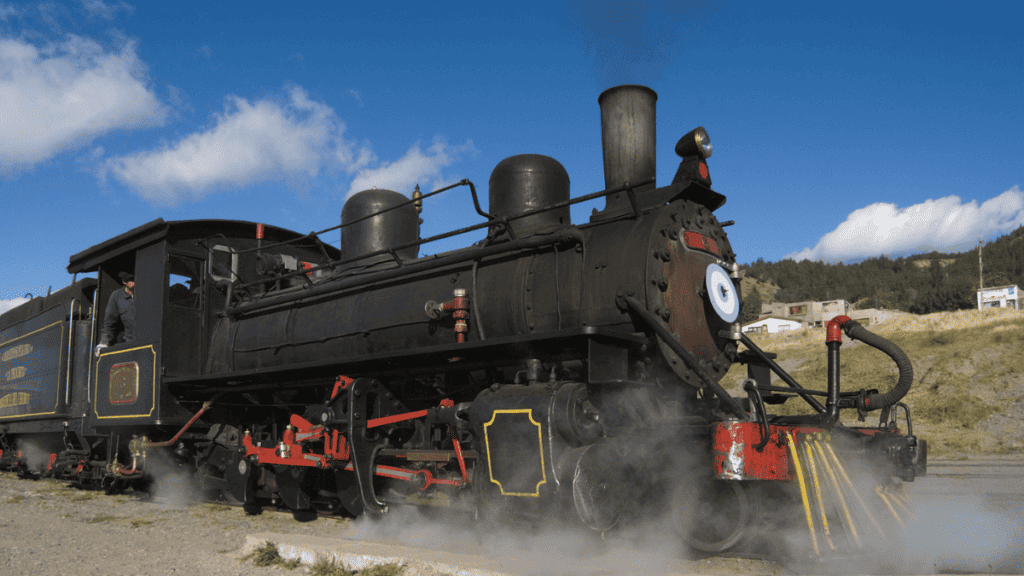
The La Trochita train covers around 250 mi (402 km) from Esquel to El Maitén, passing through several beautiful and remote Patagonian landscapes, with 1-hour break for your comfort and pleasure.
The fare for this historic train ride across the Patagonian plains starts from 12,000 ARS ($50). If you want to experience an old-school steam engine train, choose to experience the La Trochita train.
Stations, Routes, and Schedules
An extensive railway system covers all of Argentina. In some cities, you can even find multiple railway links which cover most of Argentina.
Argentina’s train system can be divided into 2 categories:
Interprovincial Trains
Interprovincial trains in Argentina provide an essential mode of transportation, connecting different provinces and regions across the country. While the availability of specific schedules, routes, and stations may change over time, you may check the railway operators.
The Argentine railway network covers various interprovincial routes, linking major cities and regions.
Interprovincial train routes include:
- Buenos Aires – Mar del Plata: This route connects the capital city of Buenos Aires with Mar del Plata, a popular coastal city known for its beaches and tourist attractions.
- Buenos Aires – Gral.Guido – Divisadero de Pinamar: This route links Buenos Aires with Gral. Guido and Divisadero de Pinamar, offering access to the Pinamar area, a renowned beach destination.
- Buenos Aires – Bragado/Pehuajó: This route acts as a bridge from Buenos Aires to the cities of Bragado and Pehuajó, located in Buenos Aires.
- Buenos Aires – Junín: This route connects Buenos Aires with the city of Junín, located in the province of Buenos Aires.
- Buenos Aires – Justo Daract / Palmira: From Buenos Aires with Justo Daract and Palmira, this route will provide access to these cities in the San Luis and Mendoza provinces.
- Buenos Aires – Rosario: This route links Buenos Aires with Rosario, a major city in Santa Fe’s province.
- Buenos Aires – Córdoba: This route connects Buenos Aires with the city of Córdoba, the province’s capital of the same name. Córdoba is known for its vibrant culture and historical sites.
- Buenos Aires – Tucumán: From Buenos Aires, this route is the bridge to San Miguel de Tucumán, the capital city of the province of Tucumán. Tucumán is rich in history and offers beautiful natural landscapes.
- Buenos Aires – Bahía Blanca: This route connects Buenos Aires with Bahía Blanca, a city in Buenos Aires known for its port and industrial activity.
Inner City Trains
Inner city trains in Argentina provide efficient and convenient transportation options within major cities and their surrounding areas.
Inner city train routes include:
- Línea Roca (Roca Line): The Línea Roca is one of the busiest suburban train lines in Buenos Aires, serving the southern part of the metropolitan area. It connects downtown Buenos Aires with destinations such as La Plata, Quilmes, Berazategui, and other towns in the southern region.
- Línea Sarmiento (Sarmiento Line): The Línea Sarmiento operates in the western part of the Buenos Aires metropolitan area. It connects downtown Buenos Aires with cities like Moreno, Merlo, Morón, and Ituzaingó, among others. The line is known for its frequent services and connects important transportation hubs, making it a popular choice for commuters.
- Línea Mitre (Mitre Line): The Línea Mitre serves the northern part of the Buenos Aires metropolitan area. It offers connections from downtown Buenos Aires to destinations such as Tigre, San Isidro, and other northern suburbs. The line is known for its scenic route along the Tigre Delta, attracting tourists and residents.
- Línea San Martín (San Martin Line): The Línea San Martín connects downtown Buenos Aires with destinations in the western part of the metropolitan area, including Moreno, José C. Paz, and Pilar. It is an important commuter line serving residential areas and providing access to educational institutions and business centers.
- Línea Belgrano Sur (Belgrano South Line): The Línea Belgrano Sur operates in the southern and southwestern areas of Buenos Aires. It connects downtown Buenos Aires with destinations like González Catán, Aldo Bonzi, and Libertad, providing transportation options to residents and facilitating access to industrial areas.
- Tren de la Costa (Coastal Train): The Tren de la Costa is a picturesque train line that runs along the coast of the Río de la Plata, connecting several charming towns and tourist attractions. It starts in the northern Buenos Aires suburb of Maipú and continues to Tigre, passing through scenic areas such as San Isidro, Vicente López, and Olivos. The Tren de la Costa offers a leisurely travel experience for tourists and locals alike.
These inner-city train lines provide essential transportation services within their respective regions, connecting commuters, residents, and visitors to various destinations in and around the cities. It’s important to note that specific schedules, routes, and stations may be subject to change, so it’s advisable to check with railway operators.
Frequently Asked Questions (FAQs) – Argentina Trains
Are There Trains in Argentina?
There are numerous trains and railway stations in every city in Argentina. The Argentinian railway system is considered one of the best in the world and is also ranked 8th for being the largest railroad network in the world.
What Is the Famous Train in Argentina?
Several Argentinian trains are famous, but the one that stands out the most is Tren de las Nubes in Salta, Argentina. It was built ages ago and took you to the northwest of Argentina near the Argentina-Chile border, one of the famous places among tourists.
What Is the Best Train Journey in Argentina?
Many consider the Tren a las Nubes as the best train journey in the country.
At one point on the railway track, the train goes up steeply, giving the passengers a great view of their surroundings, which is why the “Train to the Clouds” is famous.
What Happened to the Trains in Argentina?
During the 1990s, Argentina discarded many of its long-distance trains, which weren’t profitable or used by people. The decision was made for the betterment of the railway system.
Several main routes to Trenes de Buenos Aires, Ferrocentral, and Trenes Especiales were privatized through concession contracts.
Who Built the Argentine Railways?
The Argentinian railway system was mainly built and owned by British companies.
Conclusion – Argentina Trains
All aboard the Argentina trains for a journey through breathtaking landscapes. With easy boarding and a well-maintained rail system, train journeys in Argentina are a unique and environmentally friendly way to travel.
As you embark on your adventure, take in the sights and sounds of these historic locomotives, which are both landmarks and works of art in their own right.
Sit back and relax on your train trip. You may even notice a boost in your well-being, as studies have shown that train travel can reduce stress and enhance your overall experience.
So, why not choose a train for your next travel adventure?
Your Ultimate Travel Guide & Booking Resources
Skyscanner is my trusted ally for booking flights, guiding me to the perfect travel options while making the journey planning process a breeze with its user-friendly interface and extensive search capabilities.
12Go Asia is my ultimate travel companion in Asia, offering the best budget service platform for seamless booking of trains, buses, ferries, and flights, ensuring every adventure unfolds smoothly and effortlessly.
Booking.com is my ultimate lodging partner. It offers many accommodations worldwide and simplifies my travel experiences with its user-friendly platform and unbeatable deals.
Get Your Guide is my go-to for personalized travel experiences, enriching my journeys with unique tours and activities curated to my interests, making every adventure unforgettable and tailored to my preferences.
SafetyWing is my peace of mind on the go, offering comprehensive travel medical insurance with affordable plans and hassle-free claims, ensuring I can explore the world worry-free, knowing I’m protected wherever I roam.
LifeStraw Go Bottle is my trusted hydration companion for outdoor adventures, filtering water on-the-go to keep me safe and hydrated, ensuring every hike or travel experience is worry-free and enjoyable.
Related reads:
- 26 Best Argentina Food – Exploring the Culinary Wonders of Argentina
- Your Best Guide To A Drive Through The Ruta de Los 7 Lagos Argentina
Founder of Spark Nomad, Radical FIRE, Copywriter
Expertise: Personal finance and travel content. I’m a full-time traveler, and I’ve been to 49 countries and 5 continents.
Education: Bachelor of Economics at Radboud University, Master in Finance at Radboud University, Minor in Economics at Chapman University.
Over 200 articles, essays, and short stories published across the web.
Marjolein Dilven is a journalist and founder of Spark Nomad, a travel platform, and Radical FIRE, a personal finance platform. Marjolein has a finance and economics background with a master’s in Finance. She has quit her job to travel the world, documenting her travels on Spark Nomad to help people plan their travels. Marjolein Dilven has written for publications like MSN, Associated Press, CNBC, Town News syndicate, and more.

